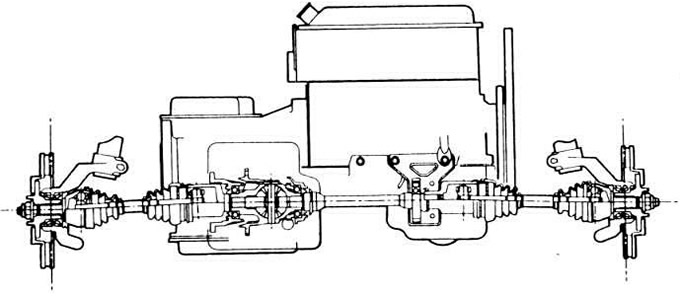The clutch pedal has a self-adjusting device that compensates for clutch wear.
The force from the engine is transmitted through the clutch and gearbox to the front wheels through two axle drives - on vehicles equipped with a 4-speed automatic transmission (see picture).

1.4, a. Location of axle drives - vehicles with 4-speed automatic transmissions have two axle drives that are approximately the same length.

1.4, b. Axle Drive Arrangement - Vehicles with manual or 3-speed automatic transmissions also use two axle drives of approximately the same length, but the right drive is attached to the gearbox via an intermediate link shaft.
In those vehicles where there is a manual or 3-speed automatic transmission, an axial drive is used on the left side, and a connecting shaft and an axial drive are used on the right side (see picture). Axial drives are approximately the same in length. The drive consists of three parts of two ends with internal splines, which are held in the differential by clips or springs, two universal joints of equal angular speeds (SHRUS) and ends with external slots, which are fastened in the hub with a nut. CV joints, in turn, have splines, as well as ball bearings, which allow them to work at different distances and at different angles, monitoring the compression and tension of the suspension. CV joints are lubricated with special grease and protected by rubber boots, which should be checked periodically for cracks, holes and leaks that could damage these components and disable the axle drive.
Warning: as a result of clutch wear, asbestos-containing dust is formed, which settles on the elements of the mechanism and is extremely harmful to your health. Do not blow it off with compressed air or inhale it. Do not use gasoline or gasoline-containing solvents to clean this dust. Wash dust into the drain pan with brake cleaner. After wiping the clutch elements with a rag, place the used rag and cleaner in a resealable container.
Visitor comments